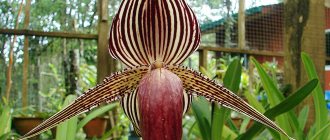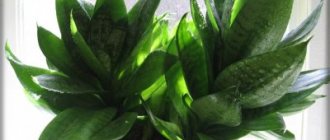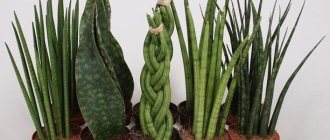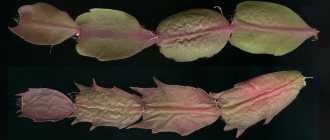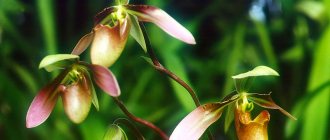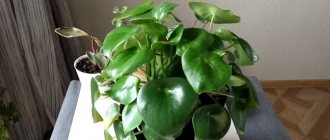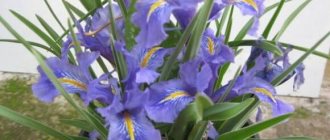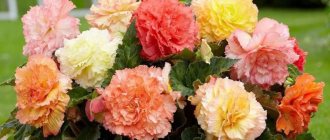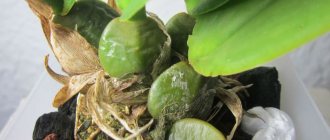Home care
- Lighting
Sansevieria golden hunny prefers bright light , responds well to open sun, and only on the nicest sunny days on the south side will it need to be shaded. On northern windows and in winter it is good to organize additional lighting.
With the optimal amount of light for these varieties, the general species “pike” pattern appears brighter, as well as white and yellow stripes on variegated forms.
- Temperature
The optimal summer temperature range is from 20 to 25 degrees , spring and autumn - 18-20 degrees , and in winter , during the dormant period - 15 degrees . Sansevieria hanni will survive a short-term drop to plus 10 degrees; but already at plus five to eight degrees the plant may die.
- Soil composition
Good growth will be provided by ready-made soil for cacti and succulents .
You can also prepare one of the following mixtures : three parts of leaf soil, two of turf and two of coarse sand; four parts turf, two parts leaf soil and one part sand.
Varieties
Flower growers distinguish several varieties of low-growing sansevieria, which were obtained on the basis of hanni. Each of them has its own differences in leaf color.
Origin, characteristics and meaning of the name Rostislav
Golden
This species was obtained on the basis of Sansevieria hanni in the 50s of the last century. A distinctive feature of the species is the presence of wide yellow stripes along the edges of the leaf blades. This was the name of the plant.
Silver
Simultaneously with the previous species, another variety of the plant was bred - Sansevieria hunny Silver. It is characterized by a silvery tint of leaves and transverse light stripes, which combine effectively with the green main background. This creates the feeling of a silvery coating on the leaves, which significantly distinguishes the flower from other plants. Like other types of Sansevieria hanni, Silver is undemanding in care.
Hanny three-way Creo
This species is characterized by a glossy leaf surface. In the center of the leaf blades there is a wide, rich green stripe of a single color. Closer to the edge there are cream stripes, on which transverse white strokes are clearly visible.
Lucille Polan
This species also belongs to the three-striped varieties of the plant. A wide strip of silver-green color runs through the center of the leaf blades. There are yellow stripes along it, and along the edge of the leaf blades there is a thin border of rich green color.
Hanny Philippine
A rare variety of Sansevieria hanni, which is difficult to find on the open market. Its characteristic feature is the golden hue of the foliage with transverse white stripes of different widths. A thin green edging runs along the edge of the leaf blades.
Hanni Streaker
This variety of plant has a wide silver stripe in the middle of the leaf. Dark green arcs with a light green cross section run along it.
Hanni Favorite
A characteristic feature of this low-growing sansevieria is the rich yellow hue of the foliage. Narrow light green stripes run along the edge and in the center of the leaf blades. It is considered one of the most elegant types of hanni, reminiscent of a ray of sunshine.
Henny Hennys Gold
One of the most interesting types of Sansevieria hanni. A wide strip of almost white color runs down the center of the leaves. Along it are green-silver stripes with transverse light strokes.
These are not all varieties of low-growing Sansevieria hanni, since each of the presented species in the process of reproduction can produce subspecies that differ in color and shade of leaves. In addition, the decorative colors may vary depending on the period of the year, lighting and regularity of fertilizing.
Landing
The container for planting Sansevieria hanni should be chosen to be ceramic, wide and shallow, corresponding to the dimensions of the plant. You can be guided by this ratio: the diameter of the pot is twice its height. There must be a drainage hole .
A drainage layer must be placed at the bottom of the planting container: small pebbles, expanded clay, broken bricks with pieces of charcoal. This layer should be thicker the younger the plant and can fill up to a third of the volume of the pot.
When planting, pay special attention to the preservation of the root system, trying to preserve the earthen ball.
- Transfer
Sansevieria hanni are replanted in the spring, in March-April . The signal for replanting is the complete entanglement of the soil with roots. Young plants give such a “signal” annually , more mature ones – once every 2-3 years .
Before transplanting, stop watering, plant in moist soil, and do not water immediately after transplanting.
- Watering
In summer, it is enough to water Sansevieria hanni once a week , and in winter - once a month . This is exactly the case when it is better to dry it than to over-moisten it.
Deciduous plants are especially protected from the ingress of irrigation water: stagnation of moisture in it leads to root rot, which will destroy the plant.
Dry air is preferable; spraying is not necessary ; you just need to periodically wipe off the dust from the leaves.
- Top dressing
During the period of active growth of sansevieria, in spring and summer, fertilizing is carried out once every two weeks with a specialized mixture for cacti and succulents .
If complex fertilizers are used, you need to take into account that they should not contain an excess of nitrogen compounds and this complex must be dissolved in a much larger amount of water than for other plants.
- Trimming
This operation is applied only to damaged leaves. They usually dry out and then such an area should be cut off, leaving a narrow dry border so that the process stops.
- Bloom
Sansevieria hanni can bloom at any time of the year - with small star-shaped flowers on an elegant peduncle. This peduncle needs to be trimmed after flowering.
To encourage the plant to flower, it is transplanted into a tight pot, only 4-5 cm wider than the previous one.
Sansevieria species
There are up to 70 types of flowers in nature, but up to a dozen varieties are popular in indoor floriculture. Moreover, flower growers use for this plant not only the classification of variety (species), but also such a concept as a sport plant. This is the name given to varieties that have significant deviations from the species, but they are not a new variety.
Conventionally, all types of Sansevieria can be divided into two varieties: plants with long vertical leaves and plants with short wide leaves forming a rosette. The most popular species is Sansevieria three-lane.
Three-lane
This species is characterized by tall, flat, dark green leaves with transverse light stripes, unevenly distributed. The width of the leaves reaches ten centimeters in length, and they can grow over a meter in height. The leaves taper towards the top, and there is a small spine at the end of the leaf. In nature, this species is distributed in the desert regions of the African continent.
Laurenti
Its long leaves, in addition to transverse light stripes, have a yellow edge. The intensity of the color depends on the lighting. With a lack of light, the stripes fade. This type of Sansevieria became the basis for the development of new varieties.
Big
Lanceolate-shaped leaves grow up to sixty centimeters, reaching a width of fifteen centimeters. Transverse stripes of a malachite hue are combined with a reddish border along the edge of the sheet. The flowers are located on a long peduncle in the form of a brush and have a greenish-white color.
Cylindrical
The leaves of this plant species are cylindrical in shape, decorated with vertical silver-white stripes and yellow streaks. The ends of the leaves are narrowed and sharp. To avoid accidental injury, at home, cork caps are placed on the tips of the leaves. The flowers of the cylindrical Sansevieria are creamy white with reddish streaks.
It is necessary to note the types of Sansevieria that have become popular in recent years. Flower growers, both professionals and amateurs, are attracted to decorative low-growing varieties. These include the following types.
Haircuts for a thin face: basic recommendations, rules and haircut options (54 photos)
Hanny
The dark green leaves are shorter than the Laurenti species. The wide leaves form a rosette resembling a vase.
Golden Hunny
It differs from the previous species (Hanni) in the presence of golden-yellow stripes on the leaves, unevenly located.
Silver Honey
This plant is a sport of the Sansevieria hanni species and has leaves of a different color. They have silver-gray shades with vaguely defined transverse stripes.
Futura
It belongs to the new varieties, differing from the Sansevieria Laurenti variety in short and wide leaves. The yellow stripe along the edge of the leaves is narrow.
Moonshine
This species also belongs to the new varieties and is similar to Sansevieria Futura in leaf shape. But it differs in the gray-green color of the leaves with a silver tint.
Compacta
The short, thin, dark green leaves have a yellow stripe along the edges. A characteristic feature of the variety is that the leaves curl slightly, giving the plant an unusual appearance.
Reproduction
At home, this Sansevieria variety is propagated by root division and cuttings. It should be taken into account that the variegated forms - hunny golden and hunny silver - will lose their color when propagated by cuttings . To preserve it, these varieties are propagated exclusively by dividing the rhizome.
- Propagation by dividing rhizomes
During spring transplantation, the extracted rhizome is cut into pieces with a sharp instrument. Each segment must have at least one growth bud. The sections are treated with fungicide or crushed charcoal and parts of the rhizome are planted in separate containers of appropriate sizes.
- Propagation by cuttings.
For such propagation, you need to select a mature leaf, cut it off, lay it with the bottom surface up and divide it with a sharp knife in the transverse direction into pieces from five to seven centimeters long. These leaf cuttings are withered for some time, then planted in moistened sand, buried a third of the length, and covered with plastic film. Moderate watering is carried out through a tray, and the greenhouse is regularly ventilated. Rooting, as a rule, occurs after one and a half to two months. Then the cuttings are grown by planting them in a standard soil mixture for sansevieria.
How to propagate
- Reproduction. The easiest and most popular way to propagate sansevieria is by dividing the plants during transplantation. During the process of growth, plants form daughter shoots, rosettes, which are also used for propagation. In this case, rosettes with already developed roots are separated from the main mother plant and planted in a mixture for adult plants. The pots are placed in a bright place and watered with a small amount of water until rooting is complete.
When taking leaf cuttings, the leaf is cut into pieces 10 cm long, placed two-thirds of the length in sand, covered with a jar and kept in a warm and bright place. The plant is ventilated daily and the level of rooting is checked by lifting the jar. Watering is carried out in the tray of the pot. This rooting method takes quite a long time, 1-1.5 months: first the roots develop, then the buds, and young leaves appear from the roots.
Signals of trouble
The leaves turn yellow - a sign of waterlogging, stagnation of water in the leaf rosette. A replantation is required, removing damaged leaves and drying the roots.
Sansevieria does not grow - as a rule, this is a consequence of too low temperatures.
Leaves with whitish spots are signs of sunburn.
Brown spots on the leaves are a sign of lack of light and excess moisture.
Leaf rotting in dry soil - the plant is kept in the cold.
Red-brown spots with a yellow border are a fungal disease.
Diseases and pests
If Sansevieria hanni is kept in more or less suitable conditions, it practically does not suffer from diseases and pests.
However, without receiving proper, not at all complicated, care, first of all, being in cold and damp conditions, the plant loses its inherent immunity and is affected by rot and fungal infections . In such cases, you should remove the affected parts, treat the cuts with fungicides, dry the roots, plant them in fresh soil and keep the plant in a warm room, watering very moderately.
spider mites or thrips can settle on it . They can be removed immediately with a soap solution, but the most effective means of combating these insects are systemic insecticidal preparations.
“Pike tails” - Sansevieria are among the most resistant plants in indoor culture. With sufficient lighting, not too low temperatures and limited watering, they retain their discreet decorative appearance for many years. In addition, well-groomed miniature rosettes of Sansevieria hanni - unpretentious inhabitants of bright window sills - not only decorate the interior, but also purify the air in the room where they are located from toxic substances such as formaldehyde and nitric oxide.
Similar plants
Since Moonshine is a variety of Sansevieria, which has about 60 species.
The closest ones to Moonshane are:
- Sansevieria cylindrical. It has long sword-shaped leaves that are highly flexible. The plant is rich green in color, covered with light spots.
- Futura. It is also called three-striped due to its color. Futura has short, wide green leaves edged with yellow stripes.
- Bacularis. This species has cylindrical dark green leaves.
- Black Coral. The leaves are lanceolate and have a characteristic color - black-green stripes located horizontally.
- Laurenti. The oldest variety of Sansevieria. The long green leaves have a clear yellow stripe.
Sansevieria Moonshine is a beautiful house plant that does not require excessive labor. It is perfect as a first experience for novice gardeners, and experienced gardeners will not disdain the unpretentious silver pike tail.
If you find an error, please select a piece of text and press Ctrl+Enter.
Photo
See more photos of Sansevieria hanni below:
Sansevieria is an unpretentious and tenacious plant and a real find for beginning gardeners. We recommend reading our articles about existing plant species, as well as the cultivation and propagation of Velvet Touch, Moonshine, three-strip and cylindrical varieties.
Bloom
When flowering, the plant produces an oblong arrow, on which there are small flowers with drops of nectar under them. The aroma of flowers is delicate. A special feature of flowering is the blooming of flowers late in the day. Flowering usually occurs in April or May.
You will learn how other species bloom, such as Velvet Touch, Laurenti, Cylindrical, Moonshine and Three-Stripe, in separate articles on the pages of our website. There we also talked about the care and propagation of these very beautiful varieties of Sansevieria.
